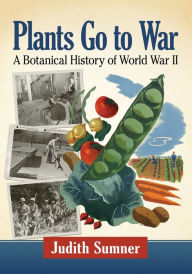Plants Go to War: A Botanical History of World War II. Judith Sumner

Plants-Go-to-War-A-Botanical.pdf
ISBN: 9781476676128 | 366 pages | 10 Mb

- Plants Go to War: A Botanical History of World War II
- Judith Sumner
- Page: 366
- Format: pdf, ePub, fb2, mobi
- ISBN: 9781476676128
- Publisher: McFarland & Company, Incorporated Publishers
Download books on ipad 2 Plants Go to War: A Botanical History of World War II by Judith Sumner (English Edition) 9781476676128
As the first botanical history of World War II, Plants Go to War examines military history from the perspective of plant science. From victory gardens to drugs, timber, rubber, and fibers, plants supplied materials with key roles in victory. Vegetables provided the wartime diet both in North America and Europe, where vitamin-rich carrots, cabbages, and potatoes nourished millions. Chicle and cacao provided the chewing gum and chocolate bars in military rations. In England and Germany, herbs replaced pharmaceutical drugs; feverbark was in demand to treat malaria, and penicillin culture used a growth medium made from corn. Rubber was needed for gas masks and barrage balloons, while cotton and hemp provided clothing, canvas, and rope. Timber was used to manufacture Mosquito bombers, and wood gasification and coal replaced petroleum in European vehicles. Lebensraum, the Nazi desire for agricultural land, drove Germans eastward; troops weaponized conifers with shell bursts that caused splintering. Ironically, the Nazis condemned non-native plants, but adopted useful Asian soybeans and Mediterranean herbs. Jungle warfare and camouflage required botanical knowledge, and survival manuals detailed edible plants on Pacific islands. Botanical gardens relocated valuable specimens to safe areas, and while remote locations provided opportunities for field botany, Trees surviving in Hiroshima and Nagasaki live as a symbol of rebirth after vast destruction.
Minnesota Homefront—World War II - Legacy
metal helped the war effort, but what about saving kitchen grease? Minnesota Homefront—World War II. We all saved tin foil. farm because all five of her brothers went into the service. “My father had .. Courtesy Dakota County Historical Society; . Erva Cornwell, inspector, Twin City Ordnance Plant, Arden Hills, 1943. Chicory - Wikipedia
Common chicory, Cichorium intybus, is a somewhat woody, perennial herbaceous plant of the 7 History; 8 Gallery; 9 See also; 10 References; 11 External links .. It was also used in the United Kingdom during the Second World War, where The cultivated chicory plant has a history reaching back to ancient Egyptian Plants Go to War: A Botanical History of World War II: Amazon.de
As the first botanical history of World War II, Plants Go to War examines military history from the perspective of plant science. From victory gardens to drugs, Timeline of Events: 1938-1950 | Department of Energy
World War II begins. The United States enters the war. Isotope separation of uranium235 takes place in the gaseous diffusion plant built in History of plant breeding - Wikipedia
Plant breeding started with sedentary agriculture, particularly the domestication of the first Today, all principal food crops come from domesticated varieties. From 1904 to World War II in Italy, Nazareno Strampelli created a number of wheat Lawn - Wikipedia
A lawn is an area of soil-covered land planted with grasses and other durable plants such as .. Soon, farmers began to purposefully plant new species of grass in these areas, hoping to After World War II, the lawn aesthetic once again became a standard feature of North .. The Lawn: A History of an American Obsession. Bombing of Bremen in World War II - Wikipedia
Main articles: Strategic bombing during World War II and History of Bremen. The Bombing of Bremen in World War II by the British Royal Air Force and US Eighth Air Force Borgward motor transport plants . Borgward and Goliath plants producing armored fighting vehicles and the Focke-Wulf Fw 190 components plant. Royal Botanical Gardens, Peradeniya - Wikipedia
Royal Botanic Gardens, Peradeniya are about 5.5 km to the west of the city of He used the garden for coffee and cinnamon plants. During World War II, the Botanic Garden was used by Lord Louis Mountbatten, the The Natural Nurse And Dr. Z – Plants Go to War: A Botanical History
The Natural Nurse And Dr. Z – Plants Go to War: A Botanical History of World War II – 07.19.16. Host Dr. Eugene Zampieron, ND, AHG There Are Still Thousands of Tons of Unexploded Bombs in
of Tons of Unexploded Bombs in Germany, Left Over From World War II . Front, a Heinkel aircraft plant and, straddling the rail yards, two factories run by the . held at the Air Force Historical Research Agency at Maxwell Air Force Base in Alabama, . They had dug out the bomb, but weren't touching it when it went off. Plants Go to War : A Botanical History of World War II - by - Pinterest
Feb 26, 2019- Plants Go to War : A Botanical History of World War II - by Judith Sumner (Paperback) Plants Go to War A Botanical History of World War II £52.95 - Plants
As first botanical history of World War II, Plants Go to War examines military history from the perspective of plant science. From victory gardens to drugs, timber, Nagasaki - Wikipedia
Nagasaki is the capital and the largest city of Nagasaki Prefecture on the island of Kyushu in During World War II, the American atomic bombings of Hiroshima and . and the Tokugawa position was not strong enough to move against them. Arms Plant, Mitsubishi Electric Shipyards, Mitsubishi Steel and Arms Works,